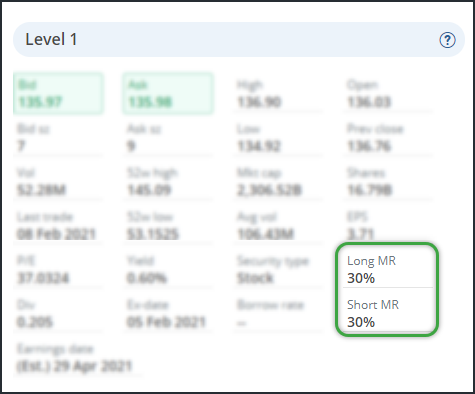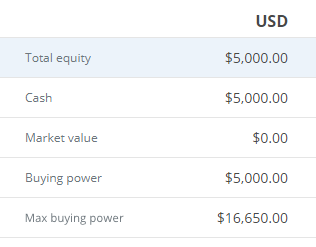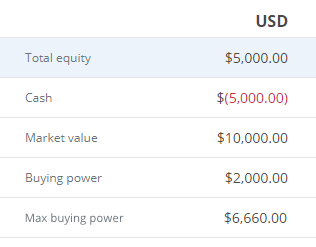Note: The information in this blog is for educational purposes only and should not be used or construed as financial or investment advice by any individual. Information obtained from third parties is believed to be reliable, but no representations or warranty, expressed or implied, is made by Questrade, Inc., its affiliates or any other person to its accuracy.
Lesson Margin 101
Margin Requirements
Understand how margin requirements are calculated.
With a self-directed Margin account, you are able to leverage your investments to borrow money to trade/invest. When you place a trade in a Margin account, your available cash is used first. If your order’s dollar amount exceeds your available cash, that’s when ‘borrowing’ starts.
Important to note: Margin accounts do not automatically convert your currency from CAD to USD (or vice-versa). All of your trades are settled in the currency of the investment, (whether you’re buying or selling) with no automatic conversion. This allows you to keep your CAD & USD balances separate, and only convert when you need to. Registered accounts like a TFSA and an RRSP have different currency settlement options available.
Check out this great guide on currency conversions within a Margin account for more information.
What is a margin requirement (MR)?
Every investment has its own margin requirement, shown as a percentage. This percentage represents the amount of buying power you have to set aside when borrowing to trade. For example, if stock ABC has a 30% margin requirement you only have to pay 30% of the trade value, while the other 70% can be borrowed from Questrade. If a security has a 50% MR, you can fund half the trade value, and the other half can be borrowed from Questrade. Some securities may have a 100% MR. With these types of investments, you cannot use margin, and have to pay for the full value of the trade without borrowing.
Every investment’s minimum margin requirement is set by our regulator CIRO and in addition, Questrade can choose to maintain higher than minimum margin requirements as it sees fit. Margin requirements are subject to change at any time with no prior notice, especially for securities dealing with high volatility, regulatory issues, or other risk-related concerns.
Example of changing margin requirements
Since margin requirements established by CIRO state that a security trading between $1.50-$1.74 has an 80% MR, let’s take a look at the following example:
Suppose you own a stock that’s trading at $2.50, and has a MR of 50%. If this stock has some bad earnings news for example, and declines to $1.70 a share, the MR would increase to 80% due to the previously mentioned CIRO rule. This can potentially cause issues if before the drop in price, your buying power was close to zero. Since the drop in price causes the Margin requirement to increase, this can potentially lead to a Margin call as a result. This is because as the margin requirement increases, your buying power would decrease.
Important to note: “Trading on Margin/borrowing” only applies after you’ve used all the available cash in your margin account. If you don’t spend more cash than what’s available in the currency of the trade, you will not be borrowing, and will not be charged interest.
Let’s check out some more examples:
Suppose you would like to buy shares of company ‘X’ shown below in the screenshot. Since this company trades for more than $2 a share, and is part of CIRO’s “List of Securities Eligible for Reduced Margin”, the MR is only 30%.

A 30% MR means you can “leverage” or borrow up to 3.33:1.
With a $1,000 cash balance for example, your Max buying power for this specific stock would be $3,333.33.
Please note: “Maxing out” your leverage could lower your account’s buying power balance to close to zero ($0). If you choose to do this and the investment declines by any amount in value while your buying power is “maxed out”, you will enter a Margin call as a result.
You can learn more about Max buying power and buying power in our Understanding your account balances article. There is also a separate ‘Long MR’ and ‘Short MR’ shown. Long MR refers to buying the security, and Short MR is when you’re shorting.
Let’s see an example trade using margin
If you have a $5,000 cash balance in your Margin account, and are looking to buy shares of company ‘X’ from earlier, your maximum buying power would be $16,650 ($5,000 x 3.33). Suppose you’d like to leave some extra buying power, so you only buy $10,000 worth of company ‘X’ shares.
Before your trade:

Cash is untouched, and your buying power equals your cash balance.
Your total buying power is $16,650.
Note: Every security has its own margin requirement, and they may be higher than 30%. That could lead to your max buying power being lower than you assumed.
(CAD balances hidden for simplicity)
After your trade:

Your cash balance is now negative since you’re borrowing to trade.
The margin required on your position is $3000 = 10,000 x 30%
Your buying power has now dropped to $2,000.
This is calculated as:
Buying Power = Total Equity - Margin Required
Buying power = $5,000 - (10,000 x 30%)
Buying power = $2,000
Your new Max buying power is 3.33 x your Buying power at $6,660.
To explore the impact of changing security prices on your balances and buying power, please check out our helpful guide to your balances.
Related lessons
Want to dive deeper?
TFSA 101
Discover what a Tax-Free Savings Account is and how it can benefit your investment goals.
View lessonExplore
Accounts 101
Explore the different account types available in Questrade and determine the right account for you.
View lesson